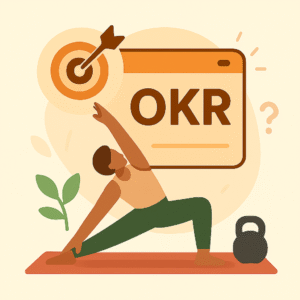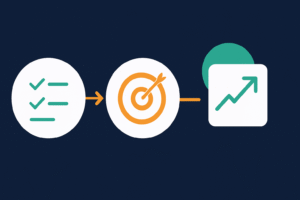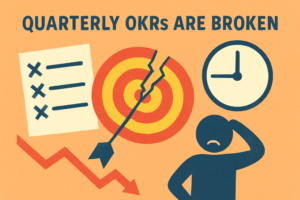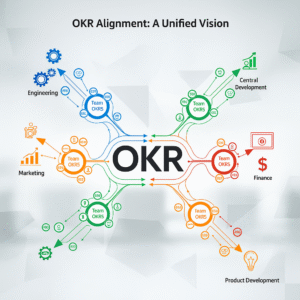When I look at agile teams, I see systems designed for adaptability: short feedback loops, rapid iteration, and a relentless focus on delivering value. Add OKRs into that system, and something interesting happens: clarity meets agility. When done well, the two amplify each other. When done poorly, they become competing forces, pulling teams in different directions and feeling like “a thing” on “a thing”.
The real question isn’t whether we should use OKRs in Agile environments. It’s how we make them work together without creating unnecessary friction.
Why OKRs and agile belong together
Let’s step back for a moment. Agile is about how we deliver value—incrementally, with flexibility. OKRs define where we want to go and how we’ll measure progress toward it. Both frameworks share a common thread: transparency, alignment, and continuous improvement.
Here’s the pattern I see. Agile thrives in complexity, and OKRs thrive in ambiguity. When combined, they provide both adaptability and direction. Atlassian puts it well:
“Static goals … become stale and meaningless. Combining clear objectives with a small set of specific, measurable results and a regular process of reviewing progress … is what makes OKRs truly useful.”
Read more on Atlassian
This isn’t about layering process on process.
This is about taking a nimble and hyper-efficient process that makes teams highly productive and then aiming it in the right direction so the desired results can be achieved.
Where it goes wrong
Just adding OKRs to your agile teams doesn’t automatically make them better. Organizations that try to implement OKRs often run into one or more of these problems:
- Having extra meetings, hiring extra people. Instead of trying to fit OKRs into their agile practice, some people think that a whole set of additional meetings are required. Or they may feel that extra roles need to be added to the company to care for the new process.
- Yet another thing. Teams are already busy and usually trying to do too much. Asking them to create/track/review OKRs without good reason and connection with everyday work just feels like more bureaucratic overhead. It’s overwhelming.
- The task list. Agile teams that are used to being given lists of tasks often mistake OKRs as things to do rather than goals to shoot for. The OKR task list misses the true power of setting objectives.
Ultimately, your OKRs can easily become disconnected from work and never really embedded as part of the agile development process. Together, they can be so much more that the sum of their parts. IBM describes the value of integration this way: OKRs enable agile transformation by anchoring priorities, making work visible, and building adaptability into execution.
Read more on IBM
Without this integration, we end up with two parallel systems that never truly intersect, and that creates confusion instead of clarity.
Five practices that actually work
I’ve seen what makes the difference between OKRs that empower Agile teams and OKRs that weigh them down. These five practices stand out:
1. Begin with clarity, not volume
Fewer, better objectives. Each should speak to a meaningful outcome—one that ties to business or customer value. Simplicity here is a form of discipline. If everything is important, nothing truly is.
2. Translate outcomes into work that fits agile
Take your Key Results and ask: What does progress look like in stories or epics? For example:
- Key Result: Increase feature adoption by 20%
- Stories: Improve onboarding flow, add contextual tooltips, refresh in-app guidance
This creates a bridge between strategic intent and daily delivery. If your backlog isn’t connected to your OKRs, the two will drift apart.
3. Put OKRs in the room
OKRs shouldn’t live in a separate tool or deck. They should surface in the conversations that drive work:
- Sprint planning: which backlog items move us closer to our objectives?
- Stand-ups: where have we made progress on outcomes, not just task completion?
- Retrospectives: how much closer are we to our goal? What did we learn about our assumptions? Where do we need to change and adapt?
Integration doesn’t happen in theory. It happens in the events where real decisions get made.
4. Keep the rhythm without locking it down
Quarterly OKRs are common, but agile teams thrive on feedback. Use sprint-level reviews to ask: Are these still the right goals? If the environment shifts, your objectives should too. Don’t feel the need to keep an objective that no longer makes sense, or has already been achieved. Agility is not just about delivery—it’s about strategy responding to change.
5. Make it visible
Dashboards work best when they show both task flow and OKR progress. Visibility creates alignment without adding more meetings. When everyone can see the connection between their work and outcomes, they will feel energized and ready to take on more.
A system that learns
When you combine OKRs and agile, you’re not just aligning goals with execution. You’re creating a system that learns. It learns what matters, how to measure it, and how to adapt when the environment shifts.
The real transformation happens when OKRs stop being a quarterly exercise and start becoming part of the team’s rhythm. A quiet, steady compass that keeps everyone oriented toward impact.
Further reading and resources
External references
- Atlassian: OKRs and Agile at Scale
- IBM: OKRs for Agile Transformation
- Quantive: The Intersection of OKRs and Agile
Other blog from Xodiac
- OKRs vs KPIs: What’s the Difference and Why It Matters
- OKR Implementation: Turn Goals into Results with FACTS
- Lost Focus: The Silent Killer of Organizational Agility
A final thought
Every agile team is like a ship navigating complex waters. The sprint cycle is the engine room, steadily keeping things moving. But without a compass, even the best engine can send you in circles. OKRs provide that compass. They point the way, not by dictating every move, but by making sure every sprint takes you closer to the destination that truly matters.
What would change in your organization if every sprint conversation was connected to the outcomes that matter most?




